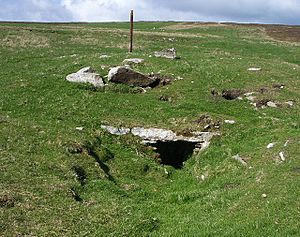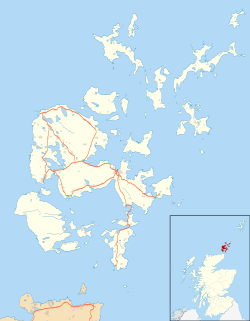Huntersquoy chambered cairn facts for kids

Huntersquoy chambered cairn
|
|
| Location | Eday |
|---|---|
| Coordinates | 59°13′27″N 2°46′05″W / 59.2241°N 2.768°W |
| Type | Chambered cairn |
| History | |
| Periods | Neolithic |
| Site notes | |
| Ownership | Historic Scotland |
| Public access | Yes |
Huntersquoy chambered cairn is an ancient stone tomb found on the island of Eday in Orkney, Scotland. It was built a very long time ago, during the Neolithic period (the New Stone Age). This was around 5,000 years ago! Huntersquoy is special because it's a rare two-story burial place with chambers built one on top of the other. It's a type of tomb called an Orkney–Cromarty chambered cairn. The site became a protected historical monument in 1936.
Contents
What is Huntersquoy Chambered Cairn?
Huntersquoy chambered cairn sits on a gentle hill. From here, you can see Calf Sound on the island of Eday in Orkney, Scotland. It is a great example of an Orkney–Cromarty chambered cairn. These tombs are sometimes called "stalled cairns." They have a main passage with upright stones. These stones divide the space into separate rooms or chambers.
This ancient tomb was built during the Neolithic era. This period was between 3000 and 2001 BC. That means it's over 4,000 years old!
A Unique Two-Story Tomb
Huntersquoy is very special because it has two levels. It's a rare double-story burial monument. From the outside, it looks like a small, round mound. It is about 10 meters (33 feet) across and 0.6 meters (2 feet) high.
It has two chambers, one above the other. The lower chamber is underground and is still mostly complete. The upper chamber, which was above ground, is now mostly in ruins.
Exploring the Chambers
Each chamber has its own entrance. The entrance to the lower chamber faces east and goes downhill. This passage is open, but it can sometimes get flooded. At the start of the lower passage, it is about 1.75 meters (5.7 feet) high. However, it quickly gets lower as you go further in.
The roof of the lower chamber was made from huge flat stones. These stones were laid across the chamber. Not much is left of the upper chamber. We know it was originally rectangular and lined up from west to east. It was probably divided into three smaller sections. Part of the upper chamber was built right over the roof of the lower chamber.
Discoveries at Huntersquoy
The monument was first explored by archaeologists in 1936. At that time, the cairn was already in ruins. Items found inside the tomb were given to the National Museum of Scotland in 1938. They were donated by Major H. Hebden, who owned the land.
See also


